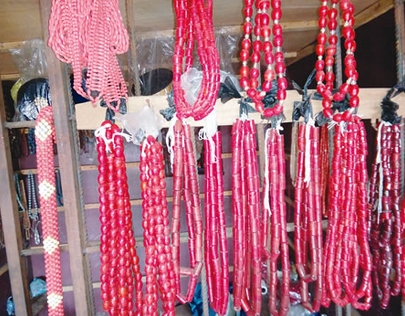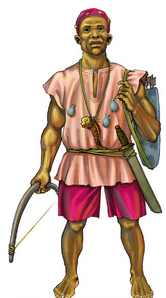
support@yorubalibrary.com
+2348073529208, 07038599574

Yoruba traditional crafts are a testament to the rich cultural heritage and artistic ingenuity of the Yoruba people. Among these crafts, beadwork stands out as a significant art form that has been practiced for centuries. Yoruba beadwork is renowned for its intricate designs, vibrant colors, and cultural symbolism. This article delves into the history, techniques, and cultural importance of Yoruba beadwork.
The History of Yoruba Beadwork
Beadwork has a long history in Yoruba culture, dating back to ancient times. Beads were initially made from natural materials such as stones, shells, and bones. With the advent of trade, glass beads became more prevalent and were highly valued. Beads were often used as currency, for adornment, and in religious rituals, symbolizing wealth, status, and spiritual power.
Techniques and Materials
1. Materials Used in Yoruba Beadwork
• Glass Beads: The most commonly used material, available in various colors and sizes.
• Coral Beads: Precious and often reserved for royalty and high-ranking individuals.
• Natural Materials: Including stones, shells, and bones, used in earlier times and still occasionally today.
2. Beadwork Techniques
• Stringing: Beads are strung together on threads to create necklaces, bracelets, and other adornments.
• Weaving: Beads are woven into fabric to create intricate patterns and designs, often used in ceremonial attire.
• Embroidery: Beads are sewn onto cloth to enhance its beauty and add texture, commonly seen in traditional clothing.
Cultural Significance of Beadwork
Beadwork in Yoruba culture goes beyond aesthetics; it carries deep cultural and symbolic meanings. Beads are used in various aspects of life, from birth to death, and hold significant roles in social, religious, and political spheres.
1. Social Status and Identity
• Royalty and Nobility: Certain beads, like coral beads, are exclusive to royalty and signify high status.
• Personal Adornment: Beads are worn to enhance beauty and signify personal identity and social standing.
2. Religious and Spiritual Uses
• Ornamentation for Deities: Beads are used to adorn idols and shrines, believed to attract and please the gods.
• Rituals and Ceremonies: Beads play a crucial role in various rituals, symbolizing purity, protection, and connection to the spiritual world.
3. Cultural Preservation and Heritage
• Traditional Attire: Beads are an essential part of Yoruba traditional attire, worn during important ceremonies like weddings, festivals, and funerals.
• Storytelling and Symbolism: Each bead and design tells a story, preserving the history and heritage of the Yoruba people.
Modern Adaptations of Yoruba Beadwork
While traditional beadwork remains significant, modern adaptations have emerged, blending old techniques with contemporary styles. Yoruba artisans are now incorporating beads into modern fashion, home décor, and art, making this traditional craft relevant in today's world.
1. Fashion and Jewelry
• Contemporary Designs: Modern jewelry designers create pieces that blend traditional Yoruba beadwork with contemporary fashion trends.
• Cultural Fashion Shows: Beadwork is showcased in fashion shows, promoting Yoruba culture globally.
2. Home Décor
• Beaded Art Pieces: Artisans create beaded artworks that decorate homes, blending traditional designs with modern aesthetics.
• Functional Items: Beads are used in creating functional items like lampshades, table runners, and more, adding a touch of Yoruba culture to everyday life.
Conclusion
Yoruba beadwork is a beautiful and meaningful art form that reflects the rich cultural heritage of the Yoruba people. From its historical significance to its modern adaptations, beadwork continues to play an essential role in Yoruba society. By preserving and promoting this traditional craft, the Yoruba people maintain a vital connection to their history and cultural identity.

Learn about the Yoruba concept of Ìwà Pẹ̀lẹ́ (good…

Learn special praises for Divine Being and Creator…